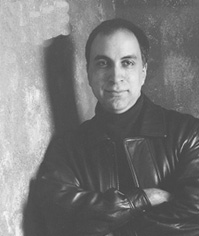
Composer Anthony Cornicello (born in Brooklyn, New York, 1964) writes music that blurs distinctions between performers and electronics, timbre and harmony, composition and improvisation, and explores the boundaries of what may be considered post-classical concert music. His music is vibrant and visceral, full of rhythmic energy and harmonic sophistication, and his forays into live electronics have led to exciting combinations of instruments and processed sound. Cornicello’s background as a jazz pianist is evident not only in the rhythmic activity of his music, but also in his constant investigation of the rich sonorities available from a variety of instruments.
He has been commissioned to write music for the Scorchio Electric String Quartet, ModernWorks! (funding from Meet the Composer/ Commissioning Music USA), the Auros Group for New Music, the Prism Saxophone Quartet, the New York New Music Ensemble, David Holzman, the Group for Contemporary Music, and the InterEnsemble of Padova, Italy. His work has also been featured on the Guggenheim Museum’s “Works and Process” series. Cornicello’s works have also been performed by the Chicago Civic Symphony, Parnassus, ALEA III, Composers Concordance, Madeleine Shapiro, Robert Black, among many other outstanding groups and solo performers. His music has been presented as part of the Darmstadt International Festival of New Music as well as the June in Buffalo Festival.
Cornicello’s Second String Quartet has been recorded by the Atlantic String Quartet; the Second Sonata for Piano by David Holzman (Centaur). More recently, his Post-Modern Waltz was recorded by Eric Moe for Albany Records. A portrait CD of Cornicello’s works is scheduled for 2006 release on Albany Records.
As a performer, he has conducted or played piano in his own works on numerous occasions. While a graduate student at Rutgers, he formed and directed the Janus Ensemble, a group dedicated to contemporary music. More recently, Cornicello has begun performing on the laptop, using a variety of interfaces and the Max/MSP program. Those performances, mostly with EEE!, have had a notable impact on his music, as EEE!’s music ranges from hip-hop to experimental noise. EEE! is based at Eastern Connecticut State University, where Cornicello is an Associate Professor and Director of the Electronic Music Lab.
Cornicello received the Ph.D. from Brandeis University, where he studied with David Rakowski, Eric Chasalow, and Martin Boykan. His teachers also include Charles Wuorinen, Gérard Grisey, and Richard Beirach.
His current fields of interest include developing unusual interfaces for live computer music performances, as well as continuing to investigate resonance and spatialization. His recent and current projects (mostly for string instruments and electronics) have been exploring the latter two, and the series of experimental works ReZenant Garden, performed by EEE! have operated on all three areas of interest. Future projects will include works for instrumental groups or soloists and electronics, as well as turntablists.
Cornicello's works are published by C.F. Peters Corporation and APNM, and he is a member of BMI.
|
|
|
|
|
|

Monday, October 24, 2005
Unpretentious music
This past Wednesday, we had Alvin Lucier come to Eastern CT, speaking to a combined audience of a few of my classes. Most of my students did the usual complaining, but quite a few enjoyed it, which made me happy. Most students are still baffled at the idea of making music not to become rich, so the concept of experimental music just blew a few circuits.
Now, for the interesting part.
We've all had this experience, where someone says just the right thing, and everything is suddenly put into perspective. Alvin was describing his "I am sitting in a room", and he tried to put it in the context of the work of the late 60s. He spoke of a dancer (was it Tricia Brown?) who choreographed a work where she told the audience exactly what she was doing, as she was doing it. She'd say, "Now I'm lifting my right leg" or "I'm now twisting my head back", while executing these moves. This was an analogy to what Lucier was doing in "I am sitting in a room". And then he said: "We were just trying to make music that was not pretentious."
For me that puts 60s experimentalism, minimalism, and even post-modernism in a new light. Of course, the first thing to think about are those photos I've seen, of Reich performing "Four Organs", wearing jeans. No suits in that bunch!
But more importantly, it divulges an attitude - that there should be no 'mystique' about the composer's work. "Here it is, let me show you," as opposed to the covert, arcane modernist rituals. "An unadorned row - heaven fofend!" "Don't be so obvious - and for God's sake, get rid of those repeats", or my favorite (a well-known Harvard composer, upon hearing my piece "Screaming Whispers"), "We've heard enough of that F - can we go to something else now?" (not realizing that the F was the main point of the piece, and that it would eventually go to something else, at the end of the work!).
Interesting to me, maybe obvious to others....
posted by Anthony Cornicello
|
| |



